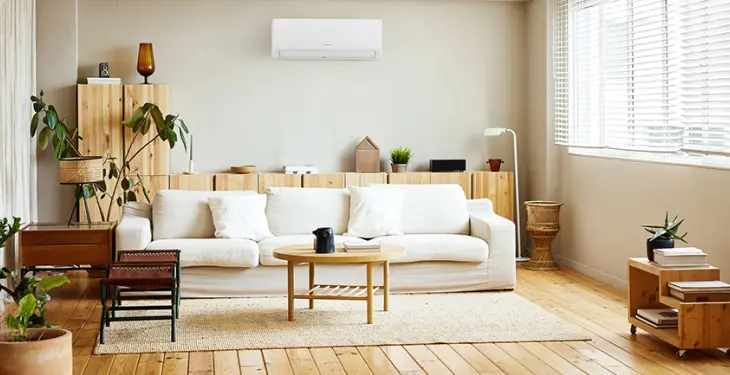

Written by Stephen Day
Gas Safe Engineer
Updated: 22nd August, 2025
Portable air conditioners are movable units designed to cool specific areas. They are especially useful in spaces where traditional air conditioners are impractical or unavailable.
Stay cool and get an air conditioning quote.
Hot flat, warm house, sticky nights. A portable air conditioner can be a quick fix while you decide on a long term cooling plan.
This guide shows how to choose the right size, what BTU and kW mean, how noisy these units are in real rooms, and which models are worth a look for UK homes in 2025.
Model | Approx price | Capacity (kW) | BTU/h | Suggested room size | Noise (dB) | Energy rating | Smart features |
MeacoCool MC Series Pro 9000 | £400 | 2.6 | 9,000 | 16 to 26 m² | 52 to 55 | A | App control on selected versions |
De’Longhi Pinguino PAC EL112 | £650 | 3.2 | 11,000 | 26 to 30 m² | 52 to 63 | A+ | Wi Fi on specific variants, humidity control features |
Russell Hobbs RHPAC11001 | £320 | 3.2 | 11,000 | 20 to 30 m² | Up to 65 | A | Remote and timer |
Inventor Chilly 9000 | £200 | 2.6 | 9,000 | 16 to 24 m² | Up to 65 | A | Compact 3 in 1, cool, fan, dehumidify |
electriQ Eco Silent 12000 | £350 | 3.5 | 12,000 | 20 to 30 m² | 53 to 65 | A | App control and sleep mode |
Prices are approximate and change often. Always check live retailer pricing.
Why it stands out
A strong all round pick for small to medium rooms. Quiet on its lower fan settings and easy to live with. It cools quickly, then settles into a gentle background flow that feels calm rather than harsh.
Best for
Bedrooms, home offices and lounges up to about 26 m².
For bedroom specific advice, see our picks for the best bedroom air conditioning units.
Pros
Quieter on low fan than many entry units
Compact footprint
Simple controls that most people grasp in minutes
Cons
Heavier than it looks
App control depends on the exact version
Typical price
Around £400.
Why it stands out
More cooling power for larger spaces, with Wi Fi on specific versions and humidity control features that make rooms feel fresher, not just colder. In a warm lounge it can pull the temperature down fast, then maintain comfort without constant fiddling.
Best for
Bigger rooms as well as open plan areas around 26 to 30 m².
Pros
Strong cooling output
Smart control on compatible versions
Effective moisture control that improves comfort
Cons
Larger and heavier
Louder at full fan speed
Typical price
Around £650.
Why it stands out
Good capacity for the money and simple controls. A sensible budget choice for midsize rooms. It gets the job done.
Best for
Bedrooms and lounges up to about 30 m² where cost matters.
Pros
Strong value
Remote and timer included
Easy to move between rooms on its casters
Cons
No smart app control
Louder than premium picks on high fan
Typical price
Around £320.
Why it stands out
The budget pick that still covers the basics, with 9,000 BTU and a compact body that suits smaller spaces.
Best for
Small to medium rooms, flats and box rooms.
Pros
Low purchase price
Three in one modes
Simple setup with a straightforward window kit
Cons
No built in Wi Fi
Louder than quieter rivals on high
Typical price
Around £200.
Why it stands out
More headroom for larger rooms with app control and a handy sleep mode that dims lights and eases fan speed.
Best for
Medium to larger rooms where you still want calmer operation on low.
Pros
App control and timers
Good cooling output for the price
Sensible balance of power and features
Cons
Bigger and heavier than 9,000 BTU units
Hose placement needs a little planning
Typical price
Around £350.
Use floor area as your first filter. Measure length and width, then multiply for square metres.
16 to 18 m², around 7,000 to 9,000 BTU
18 to 30 m², around 9,000 to 12,000 BTU
30 to 40 m², around 12,000 to 14,000 BTU
If you have large south facing windows, high ceilings or lots of heat sources, choose the upper end of the range.
Both measure cooling capacity. BTU is common on packaging and product listings. kW is the standard metric unit and matches your electricity bill. One kW equals 3,412 BTU per hour. If you want to compare running costs, use kW as your base unit.
Around 50 to 55 dB on low feels like a fridge hum in another room
60 to 65 dB on high is closer to a dishwasher
Use high fan for quick cool down, then switch to low for TV or sleep once the room reaches temperature.
All portable ACs need to exhaust warm air outside. A good window kit and a tight seal stop hot air leaking back in. Keep the hose as short and straight as possible. Longer, coiled and pinched hoses reduce performance and increase noise. If your window opens sideways or tilts, look for a fabric seal with a zip opening. If it slides, a rigid plate kit is usually best.
Pick a kit that suits your window style and seals well.
Sash windows, look for slide in panels with brush or gasket seals
Sliding windows and doors, use plate kits that clamp into the opening, or a patio door vent kit
Side hinged windows, fabric seal kits with zip openings work well if fitted tight
A good seal keeps hot air out and helps the unit run quieter.
Labels help, but actual cost depends on input power and your tariff. At a typical summer unit rate of around 25.73 pence per kWh, a unit drawing 0.95 kW costs roughly 24 to 25 pence per hour while cooling. Larger 12,000 BTU units may draw closer to 1.0 to 1.2 kW on active cooling. Check the spec sheet to see the input power for your chosen model.
7) Real UK running cost examples
Two simple scenarios help set expectations.
Nine thousand BTU unit in a 16 to 20 m² bedroom, assume an input around 0.8 to 0.95 kW while cooling. At 25.73 pence per kWh that is roughly 21 to 24 pence per hour. If you run it for three hours before bed on forty summer nights, expect about twenty five to thirty pounds for the season.
Twelve thousand BTU unit in a 25 to 30 m² lounge, assume an input around 1.0 to 1.2 kW. That is roughly 26 to 31 pence per hour. If you run it for four hours on forty summer days, expect about forty two to fifty pounds.
Real bills vary with insulation, setpoint, fan speed and how well you seal the window kit. Lower the setpoint a little, shut doors, draw curtains in strong sun, and the unit works less for the same comfort.
Wi Fi control for pre cooling before you get home
Sleep mode to dim lights and reduce fan speed overnight
Timers to switch off once the room is comfortable
These are handy if they match how you will use the unit. Do not pay for features you will never touch. If you are weighing up high end fans as an alternative, see our Dyson air con range guide.
Leave space behind and to the sides so the unit can breathe. Keep curtains and furniture clear of the intake. Shut doors to contain the cool air in the target room. A short, straight hose improves performance and reduces noise.
Clean or replace filters every few weeks in summer. Self evaporating models reduce emptying, but many still need an occasional drain. Store upright and dry over winter. If you hit a fault code, our guide to air conditioning unit errors and fixes will help you decide what to do next.
Room size in m² and BTU or kW matched to that size
Window kit type that suits your window and a good sealing method
Hose length and a clear route to the window
Dimensions and weight if you plan to move it often
Input power so you can estimate running costs
App control, timers and sleep mode if useful to you
Condensate handling and filter access
Warranty and returns
Want quieter, whole home comfort? See our list of the best wall mounted air conditioning and get a feel for install options.
Portable units are plug in, renter friendly and start around a couple of hundred pounds. They work well for occasional hot spells and single rooms. They are noisier and less efficient than installed systems, and the hose and window kit are part of the deal. The appeal is clear. You can buy today, cool tonight.
A wall mounted split system is quieter, more efficient and better for daily use. The compressor sits outside, so the indoor unit can run at gentle fan speeds that suit bedrooms and living rooms. You get steady cooling without the window kit or the hose, and many systems also deliver efficient heating as a heat pump. Installation costs more up front, yet ongoing comfort and lower noise make splits the right choice for regular use. For a side by side view, read portable vs wall mounted air conditioning.
Ready to explore installed options for your home? Start with the best air conditioning units UK and compare features.
For a quiet night in a smaller room, the MeacoCool MC Series Pro 9000 is a great starting point. For bigger spaces, the De’Longhi Pinguino PAC EL112 brings stronger cooling and useful humidity control. On a tight budget, the Inventor Chilly 9000 covers the basics for small to medium rooms. If you want more headroom and app control at a sensible price, the electriQ Eco Silent 12000 is well balanced. The Russell Hobbs RHPAC11001 is solid value if you do not need a smart app.
Pick by room size, seal the window kit well and keep an eye on input power if you care about bills. When daily comfort matters, a split system will always feel calmer and cost less to run across a long summer. Stay cool, sleep better, spend less today.
Compare options and next steps in our guide to air conditioning costs.
Last updated: 22nd August, 2025

Written by Stephen Day
Gas Safe Engineer at iHeat
Stephen Day is a Gas Safe registered and FGAS certified engineer with over 20 years of hands-on experience in the heating, cooling, and renewable energy industry, specialising in boiler installations, air conditioning, and heat pump systems.
LinkedInArticles by Stephen Day are reviewed by iHeat’s technical team to ensure accuracy and reliability.

19th November, 2025
This guide helps you choose the best type of air conditioning for your UK home.
 Read Article
Read Article

22nd August, 2025
Portable air conditioners are movable units designed to cool specific areas. They are espe...
 Read Article
Read Article

19th August, 2025
Portable and wall mounted air conditioning both have their own strengths and drawbacks dep...
 Read Article
Read Article
No obligation. Takes less than 60 seconds.